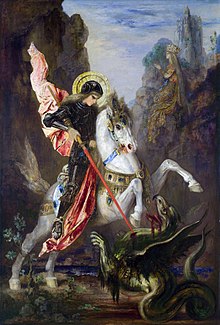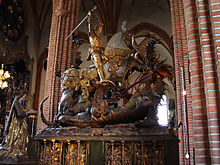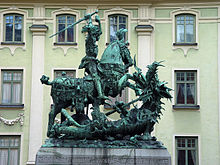Saint George and the Dragon

The dragon motif was first combined with the already standardised Passio Georgii in Vincent of Beauvais' encyclopedic Speculum Historiale, and then Jacobus de Voragine's Golden Legend (ca 1260) guaranteed its popularity in the later Middle Ages as a literary and pictorial subject.[5] The legend gradually became part of the Christian traditions relating to Saint George and was used in many festivals thereafter.[6]
Contents[show] |
[edit] The legends


| “ | Advance our standards, set upon our foes Our ancient world of courage fair St. George Inspire us with the spleen of fiery dragons..... Richard III. act v, sc.3. | ” |
| “ | Come not between the Dragon and his wrath.....Shakespeare. King Lear. Act I, Sc 2 | ” |
The town had a pond, as large as a lake, where a plague-bearing dragon dwelled that envenomed all the countryside. To appease the dragon, the people of Silene used to feed it two sheep every day, and when the sheep failed, they fed it their children, chosen by lottery. It happened that the lot fell on the king's daughter, who is in some versions of the story called Sabra.[8] The king, distraught with grief, told the people they could have all his gold and silver and half of his kingdom if his daughter were spared; the people refused. The daughter was sent out to the lake, decked out as a bride, to be fed to the dragon.
Saint George by chance rode past the lake. The princess, trembling, sought to send him away, but George vowed to remain. The dragon reared out of the lake while they were conversing. Saint George fortified himself with the Sign of the Cross,[9] charged it on horseback with his lance and gave it a grievous wound. Then he called to the princess to throw him her girdle, and he put it around the dragon's neck. When she did so, the dragon followed the girl like a meek beast on a leash.
She and Saint George led the dragon back to the city of Silene, where it terrified the people at its approach. But Saint George called out to them, saying that if they consented to become Christians and be baptised, he would slay the dragon before them. The king and the people of Silene converted to Christianity, George slew the dragon, and the body was carted out of the city on four ox-carts. "Fifteen thousand men baptized, without women and children." On the site where the dragon died, the king built a church to the Blessed Virgin Marycured all disease.[10] and Saint George, and from its altar a spring arose whose waters
Traditionally, the sword[11] with which St. George slew the dragon was called Ascalon, a name recalling the city of Ashkelon, Israel. From this tradition, the name Ascalon was used by Winston Churchill for his personal aircraft during World War II (records at Bletchley Park), since St. George is the Patron Saint of England.
[edit] Origins

The region had long venerated other religious figures. These historians deem it likely that certain elements of their ancient worship could have passed to their Christian successors. Notable among these ancient deitiesSabazios, the Sky Father of the Phrygians and known as Sabazius to the Romans. This god was traditionally depicted riding on horseback. was
The iconic image of St. George on horseback trampling the serpent-dragon beneath him is considered to be similar to these pre-Christian representations of Sabazios, the mounted god of Phrygia and Thrace.
According to Christopher Booker it is more likely, however, that the "George and the Dragon" story is a medieval adaptation of the ancient Greek myth of Perseus and Andromeda—evidence for which can be seen in the similarity of events and locale in both stories.[12] In this connection, the Perseus and Andromeda myth was known throughout the Middle Ages from the influence of Ovid. In imagery, other Greek myths also played a role. "Medieval artists used the Greco-Roman image of Bellerophon and the Chimaera as the template for representations of Saint George and the Dragon."[13]
These myths in turn may derive from an earlier Hittite myth concerning the battle between the Storm God Tarhun and the dragon Illuyankas. Such stories also have counterparts in other Indo-European mythologies: the slaying of the serpent Vritra by Indra in Vedic religion, the battle between Thor and Jörmungandr in the Norse story of Ragnarok, the Greek account of the defeat of the Titan Typhon by Zeus.[14]
Parallels also exist outside of Indo-European mythology, for example the Babylonian myths of Marduk slaying the dragon Tiamat[15]. The book of Job 41:21 speaks of a creature whose "breath kindleth coals, and a flame goeth out of his mouth."[16]
In Italy, Saint Mercurialis, first bishop of the city of Forlì, is also depicted slaying a dragon.[17] Saint Julian of Le Mans, Saint Veran, Saint Bienheuré, Saint Crescentinus, Saint Margaret of Antioch, Saint Clement of Metz, Saint Martha, Saint Quirinus of Malmedy, Saint Donatus of Arezzo, and Saint Leonard of Noblac were also venerated as dragon-slayers.[18]
[edit] Treatment by artists
- Paintings
- Paolo Uccello, Saint George and the Dragon, c. 1470. National Gallery, London.
- Giovanni Bellini, Saint George Fighting the Dragon, c. 1471. Pesaro altarpiece.[19]
- Raphael (Raffaello Santi), St. George, 1504. Oil on wood. Louvre, Paris, France.
- Raphael (Raffaello Santi), St. George and the Dragon, 1504–1506. Oil on wood. National Gallery of Art, Washington, D.C., United States
- Tintoretto (Jacopo Robusti), St. George and the Dragon, 1555.[20]
- Peter Paul Rubens, Saint George and the Dragon, 1620.
- Edward Burne-Jones, St. George and the Dragon, 1866.[21]
- Gustave Moreau, St. George and the Dragon, c. 1870. Oil on canvas. The National Gallery, London.
- Briton Rivière, St. George and the Dragon, c. 1914.
- Sculptures

- Bernt Notke, wood, Storkyrkan in Stockholm, ca. 1484–1489.[22]
- Salvador Dalí, Saint George and the Dragon, ca. 1977–1984
- Engravings
- Benedetto Pistrucci, engraving for coin dies, 1817.
- Other
- Edward Elgar, The Banner of St George: a ballad for chorus and orchestra, words by Shapcott Wensley, 1879.
[edit] Contemporary retelling


- The 1898 Dream Days by Kenneth Grahame includes a chapter entitled The Reluctant Dragon, in which an elderly St. George and a benign dragon stage a mock battle to satisfy the townsfolk and get the dragon introduced into society. Later made into a film by Walt Disney Productions, and set to music by John Rutter as a children's operetta.
- The Dragon Knight, a series of books by Gordon R. Dickson, adopted this story as a past event into its canon, significant in that dragons had since referred to humans as 'georges.' The story of St. George and the Dragon is referred to on occasion, but never told. The first book in the series, The Dragon and the George, is a retelling of a previous short story by the same author, "St. Dragon and the George".
- In the 1950s, Stan Freberg and Daws Butler wrote and performed St. George and the Dragon-Netspoof of the tale and of Dragnet) for Freberg's radio show. The story's recording became the first comedy album to sell over 1 million copies. (a
- A 1975 episode of "Space: 1999" titled "Dragon's Domain" made reference to the legend of St. George and the Dragon. A crewman from the space station heroically kills a dragon-like creature after it has consumed other astronauts. The main character played by Barbara Bain eventually concludes that the crewman's story will create new mythology similar to the legend of St. George.
- The 1981 Paramount Pictures/Disney film Dragonslayer was loosely based on the tale.[23]
- EC Comics published a comic called "By George!!" in Weird Fantasy #15. The story revealed that the 'dragon' was in fact a lost, misunderstood alien child who didn't mean any harm.
- Margaret Hodges retold the legend in a 1984 children's book (Saint George and the Dragon) with Caldecott Medal-winning illustrations by Trina Schart Hyman.
- American artist Butt Johnson uses the theme in a drawing entitled "Mario, Patron Saint of Brooklyn"Super Mario Bros., and featuring Mario in the role of Saint George – slaying the "dragon" (King Koopa). portraying characters from the video game
- The poem "Fairy Tale" by Yury Zhivago–the main character from Boris Pasternak's novel "Doctor Zhivago"–relates a modified account of this legend; Yury's poem differs in that it is nonreligious and makes no mention of the village.
- In Elizabeth Kostova's The Historian[24], Saint George is chronicled as being the saint who killed Vlad Tepesh[25] (also known as Dracula, which means "son of the dragon" or "son of the devil").
[edit] Alternative legends
The village of Wormingford in Essex, England also lays claim to the George and the Dragon legend. A dragon, now believed to have been a crocodile that escaped from Richard I, was slain in the River Stour. There are differing accounts, including different dragon slayers, however one popular account tells how Sir George Marney (of Layer de la Haye) killed the dragon with his lance. The church in Wormingford (which is dedicated to St Andrew) has a stain glass window depicting this scene. [26] [27][edit] See also
| Wikimedia Commons has media related to: Saint George and the Dragon |
[edit] Notes
- ^ Robertson, The Medieval Saints' Lives (pp 51-52) suggested that the dragon motif was transferred to the George legend from that of his father fellow soldier saint, Saint Theodore Tiro. The Roman Catholic writer Alban ButlerLives of the Saints) was at pains to credit the motif as a late addition: "It should be noted, however, that the story of the dragon, though given so much prominence, was a later accretion, of which we have no sure traces before the twelfth century. This puts out of court the attempts made by many folklorists to present St. George as no more than a christianized survival of pagan mythology." (
- ^ Walter 2003:128, noted by British Museum Russian Icon "The Miracle of St George and the Dragon / Black George".
- ^ Christopher Walter, The Warrior Saints in Byzantine Art and Tradition 2003:141, notes the earliest datable image, at Pavnisi, Georgia (1154-58), but earlier examples datable by style are at Adisi], Armenia (late eleventh century), and Bočorma (ca. 1100) and twelfth-century examples in Russia and Greece
- ^ Patriarchal Library, Jerusalem, codex 2, according to Christopher Walter, The Warrior Saints in Byzantine Art and Tradition 2003:140; Walter quotes the text at length, from a Russian translation.
- ^ Margaret Aston, Faith and Fire Continuum Publishing, 1993 ISBN 1-85285-073-6 page 272
- ^ Christian Roy, 2005, Traditional FestivalsISBN 978-1-57607-089-5 page 408; Dorothy Spicer, Festivals of Western Europe, (BiblioBazaar), 2008 ISBN 1-4375-2015-4, page 67
- ^ Quoted in Walter 2003:141.
- ^ http://www.mainlesson.com/display.php?author=langm&book=saints&story=patron
- ^ In the earliest, Georgian version where the dragon is more clearly a representation of paganism, or at least of infernal power, the sign of the Cross itself was sufficient to defeat the dragon.
- ^ Thus Jacobus de Voragine, in William Caxton's translation (On-line text).
- ^ Ascalon, Askalon (Seven Champions); Askelon (Percy's ballads)
- ^ Booker, Christopher (2004). The Seven Basic Plots. Continuum. pp. 25–26. ISBN 978-0-8264-5209-2.
- ^ Theoi Greek Mythology.
- ^ Mallory, J. P. (1989). In Search of the Indo-Europeans. Thames and Hudson. ISBN 0-500-27616-1.
- ^ Combat of Marduk and Tiamat in the Babylonian Creation Myths, Fourth Tablet at Sacred-texts.com The killing of Tiamat is featured from line 93
- ^ Job 41;21
- ^ Catholic Encyclopedia: Forli
- ^ Sauroctones
- ^ [1]
- ^ [2]
- ^ [3]
- ^ Nordisk familjebok. 1914. http://runeberg.org/nfbt/0053.html.
- ^ No Land is an Urland- The Creation of the World of Dragonslayer by Danny Fingeroth from Dragonslayer- The Official Marvel Comics Adaptation of the Spectacular Paramount/Disney Motion Picture!, Marvel Super Special Vol.1, No. 20, published by Marvel Comics Group, 1981
- ^ The Historian
- ^ Vlad tepes
- ^ http://www.bures-online.co.uk/dragon/worm.htm
- ^ http://www.dedhamvalesociety.org.uk/Files/VillageWORMINGFORD.pdf
[edit] References
- Loomis, C. Grant, 1949. White Magic, An Introduction to the Folklore of Christian Legend (Cambridge: Medieval Society of America)
- Whatley, E. Gordon, editor, with Anne B. Thompson and Robert K. Upchurch, 2004. St. George and the Dragon in the South English Legendary (East Midland Revision, c. 1400) Originally published in Saints' Lives in Middle English Collections (on-line text: Introduction).
- Catholic Encyclopedia, "Saint George"
- (Kalamazoo, Michigan: Medieval Institute Publications) (On-line Introduction)
[edit] External links
- Saint George church in Dolinka (Hungarian: Inám)
- St George and the Dragon Felt Board Story from Felt Works
- St George and the Dragon Events and Ideas - Official Website for Tourism in England
- St George Unofficial Bank Holiday: St. George and the Dragon, free illustrated book based on 'The Seven Champions' by Richard Johnson (1596)
- St George's Bake and Brew
- [4]: St. George 3 Ruble Coin







